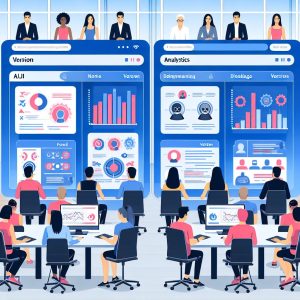Augmenting Digital Marketing Learning with GenAI
Institution: Trinity College Dublin
Discipline: Marketing
Author: Kisito F. Nzembayie
GenAI tool(s) used: ChatGPT, Midjourney, and HeyGen
Situation / Context
I lecture across our MSc Entrepreneurship and Innovation, MSc Management, and Executive Education programmes. In this case, I describe the use of GenAI in a digital marketing module designed for students in our MSc in Management programme. The module was delivered from September to October 2023 to a cohort of over 51 students. This was my second year teaching the course at Trinity.
Given the fast pace of technological change, digital marketing curricula must be regularly updated to remain relevant. As such, this module fully embraced GenAI in marketing. To reflect the evolving AI-driven marketing landscape, I aimed to expose students to key digital marketing technologies, including ChatGPT, Midjourney, and HeyGen, as part of the content marketing lessons.
Recognising the potential for AI to facilitate cheating and uncritical thinking, I redesigned the assessments to be more authentic, embedding four learning theories into a holistic experiential learning framework. These included social constructivism, demonstrated through collaborative learning; cognitivism, emphasising critical reflection; behaviourism, marked by knowledge transmission through lectures; and connectivism, which values the networked nature of digital learning. This extended pedagogy integrated the dimensions of experiential, presentational, propositional, and practical knowing (Heron & Reason, 2006) (Nzembayie et al., 2024).
The new assessment design consisted of a 30% critical reflective essay (introduced this year), a 40% group project, and a 30% individual project based on the group project findings. In their groups, students analysed the digital marketing efforts of four lesser-known Irish companies, producing detailed reports, content, and video presentations. They developed digital marketing strategies and content marketing campaigns to address the weaknesses identified in the companies’ digital marketing activities. For the individual project, each student selected a specific area of weakness from the group project and developed and implemented digital marketing strategies. This individual assessment, worth 30%, was submitted as a report, accompanied by AI-generated SEO articles, promotional videos, images, and the prompts used, all included in the appendices. The final 30% reflective piece required students to highlight their experiences and insights gained from both projects and the course as a whole. This assessment aimed to foster authentic, collaborative, and reflective learning. The use of lesser-known companies and real-world scenarios encouraged genuine engagement and authentic assessments, promoting practice-based critical thinking.
Task / Goal
I set out to achieve three main things with GenAI as part of this module: a) to equip my learners with the most up-to-date awareness of how AI and GenAI tools were transforming marketing, b) to develop skills in the use of GenAI tools and best practices for content marketing, and c) to steer students toward self-discovery and critical thinking regarding the ethical issues involved with GenAI use, consistent with an education model geared toward first-person transformation (Nzembayie & Coghlan, 2024). Hence, students kept a reflective journal throughout the course that captured their thinking and learning journey in real-time.
A final reflective piece involving critical incidents of learning was supposed to distil lessons from their reflective logs as part of a 30% assessment. This also gave me insights into their thinking as most of them engaged with multiple GenAI tools in a marketing context. For instance, although some students had an understanding of and exposure to GenAI, it was interesting to learn how they were yet to make the connection to marketing and the ethical challenges involved.
Actions / Implementation
I embedded GenAI content in my teaching resources to model best practices for GenAI use. For example, I used illustrative images generated with Midjourney in my slides and AI-generated videos featuring my avatar and cloned voice to spark curiosity and discussion (see figure below).

Fig. 1 AI-generated video using HeyGen.
These discussions explored ethical issues such as deepfakes and subtle reinforcement of biases as shown in a case where image generation AI consistently returned male only candidates for certain roles. Students were asked to reflect on some of the outputs, identifying subtle reinforcement of biases and ethical dilemmas.
These videos created using HeyGen, an AI video creation tool, introduced the role of AI in content marketing and intrigued students about their creation process, prompting classroom discussions even among advanced users. As students developed content marketing strategies for four Irish companies as part of a group project, they used these AI tools and documented their prompts, prompt revisions and AI artefacts to include as appendices in a final report.
I introduced techniques for prompting engineering in class using model prompts that generated various content types. For instance, I generated realistic photos with Midjourney for smart street bins to be included in a blog post or promotional campaign (see Fig. 2), which was one of the four cases the students were working on.
 Fig. 2 Photo realistic images of a smart bin on the Streets of London to go with a blog post – Midjourney.
Fig. 2 Photo realistic images of a smart bin on the Streets of London to go with a blog post – Midjourney.
The students learned to write SEO (Search Engine Optimised) blog posts faster by strategically prompting ChatGPT and subsequently personalising the output with market research.

Fig. 3 Student samples of AI-generated video using HeyGen.
Outcomes
Student engagement and reflection demonstrated real-time transformation, leading to more impactful learning outcomes than would have been possible without GenAI. While students were allowed to use GenAI to enhance the readability of reports, authentic learning was most evident in the student reflections and varied outputs.
There were no credible instances of AI-aided plagiarism, as the high level of authenticity in the deliverables was self-evident. I recognise that GenAI can be used to produce reflective essays.
However, I believe the solution to this challenge lies in the careful design of lessons and activities, with a focus on authenticity. For example, basing tasks on lesser-known Irish companies ensured students genuinely engaged with the project. If they had relied on GenAI, the outputs would have been too generic, prompting face-to-face interviews to verify the work’s authenticity—something I highlighted as part of a deterrence strategy at the start of the course.
Additionally, the course design featured three different assessments with various artefacts. A final reflective piece that failed to integrate elements from those activities would have raised concerns—something that did not occur. The assessments included a range of artefacts, such as videos, screenshots, and graphs, showcasing true engagement with the tasks. Therefore, while GenAI was part of the project-based learning process, it was used to complete tasks and improve readability, not to plagiarise.
Guidance on how to critically reflect was also key, and I provided this in the first lesson. I emphasised that reflection should be an ongoing practice, with students documenting their experiences in real time to ensure credibility. This was reinforced in every meeting. Consequently, the assessments clearly showed students engaging in both reflection-in-action and reflection-on-action.
Reflections
Firstly, not all students had access to cutting-edge GenAI tools or could afford them. Therefore, it is essential to have free versions available. Likewise, I would ask the college to sign up for paid versions of these tools for students to use next time. There is a danger of unequal access if some students can afford to subscribe to paid versions of these technologies while others can’t.
Next time, we will deepen our exploration with technological advances in GenAI – e.g., have students develop custom GPTs to automate several marketing activities. This will certainly require subscriptions, which may not be available. Secondly, while an authentic model of learning based on varied assessment artefacts can help enhance student learning and protect the integrity of business school assessments, grading is extremely time-consuming, in addition to delivery being much more involved. However, seeing students make noticeable transformations in such a short space of time keeps me going.
Further Reading
Heron, J., & Reason, P. (2008). Extending epistemology within a co-operative inquiry. The Sage handbook of action research: Participative inquiry and practice, 2, 366-380.
Nzembayie, K. F., & Coghlan, D. (2024). Entrepreneurship education as first-person transformation: Interiority as an operationalising mechanism. Journal of Business Venturing Insights, 21, e00471.
Nzembayie, K. F., Buckley, A. P., & Talay, I. (2024). Experiential pedagogies for cultivating entrepreneurial mindsets: Action design learning as tailored framework. Entrepreneurship Education and Pedagogy, 25151274241292276.
Digital Resources
- Text generation: https://chatgpt.com/
- Video generation: https://app.heygen.com/home
- Image generation: https://www.midjourney.com/home
Author Biography
Dr Kisito F. Nzembayie is an Assistant Professor in Entrepreneurship and Director of the MSc in Entrepreneurship and Innovation at Trinity Business School, TCD. He holds a PhD in Digital Entrepreneurship and lectures at the nexus between entrepreneurship, digital technology, marketing, and business strategy.


